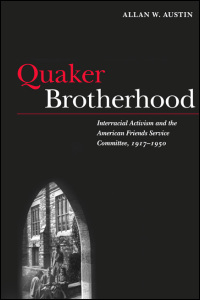 The abolitionist work of Quakers during the antebellum era has been well documented, and their contemporary anti-war and anti-racism work is familiar to activists around the world. Allan W. Austin, a professor of history at Misericordia University, answered our questions about his new book Quaker Brotherhood: Interracial Activism and the American Friends Service Committee, 1917-1950.
The abolitionist work of Quakers during the antebellum era has been well documented, and their contemporary anti-war and anti-racism work is familiar to activists around the world. Allan W. Austin, a professor of history at Misericordia University, answered our questions about his new book Quaker Brotherhood: Interracial Activism and the American Friends Service Committee, 1917-1950.
Q: What is the American Friends Service Committee?
Austin: The AFSC was created by Quakers after the United States entered World War I in 1917. Its founders initially saw the AFSC as a way for Friends to cooperate in finding alternatives to military service for conscientious objectors. The AFSC, however, pretty quickly began to diversify its work, expanding well beyond its initial objectives within its first few years. Evolving into one of the leading service organization for Friends, the AFSC took on any number of social issues, including humanitarian service (at home and abroad) and pacifism in addition to the interracial activism explored in Quaker Brotherhood. The AFSC (and the Friends Service Committee of Great Britain) received, on behalf of Quakers worldwide, the Nobel Prize for Peace in 1947, and it has remained an active organization in the years since.
Q: Why do you think, up until now, there has been a gap in scholarship on the
Friends’ post-Civil War period?
Austin: I suppose many factors contribute to this gap. The abolitionist crusade is obviously a big story, full of drama and situated at the fault line of the Civil War, which forever altered the course of United States history. Abolitionism and the Civil War remain popular topics today, too, because these stories, it seems to me, translate neatly into (admittedly oversimplified) narratives of a heroic crusade against an evil institution and racism. For some Friends, focusing on memories of their past interracial heroism has from time to time provided an escape from confronting vexing interracial problems in their contemporary world.
In addition, the absence of Quakers in our memories of post-Civil War American history reflects the broader absence of an appreciation on the part of historians for the influence of religion after the Civil War. As we move forward into the history of “modern” America, religion often fades away, no longer considered a serious motivating force in the twentieth century and beyond. Despite this tendency among scholars, for Friends, religion did still matter dearly and motivated some to act to address racism and inequality.
Finally, the dwindling number of Quakers in the United States over the past one hundred-plus years has removed Friends a bit from more contemporary historical memories. Quakers loomed a bit larger in the story of early American history, but seem a less prominent force today.
Q: What sort of “complicated connections” between Quakers and race were there during this time period?
Austin: Because Quakers have often been painted as either crusading, flawless heroes who attacked racism or (in counterpoint to such valorous images) as hypocrites who talked about the evils of racism while succumbing to it within their own institutions at the very same time, nuance is often missing in popular memories of Friendly interracialism. While many people have thus focused on a simplistic story of good versus evil, the relationship between Quakers and race actually reveals tremendous complexity. Some individuals, for instance, risked a good deal to stand against racial inequality, but their battles often pitted them against fellow Friends who were less progressive on such matters as well as the broader society. Furthermore, even those Quakers who felt moved at times to act against racism adopted programs that were hardly untainted by racialized attitudes. While this is true of any number of organizations and individuals throughout American history, we often don’t see Quakers in this same and very complex way.
Q: How did Quaker connections and relationships vary across different ethnic
groups?
Austin: The relationships did not vary as much as one might suppose, although AFSC staffers at times tended to view different groups from different perspectives. Thus, to cite one example, while the key ideas motivating their work with African Americans and Japanese Americans remained fairly consistent, Quakers in the AFSC tended to see African Americans as a “domestic” and Japanese Americans as an “international” problem. Thus, they tended to present programs to better understand African Americans—through “tours of understanding” in 1920s Philadelphia or post-WWII employment programs—in the context of improving internal race relations.
Work with Japanese Americans, alternatively, always weighted the outside world a bit more, whether that be through inviting Japanese students to study at institutions of higher learning in the 1920s United States or in helping Japanese Americans resettle from government-run concentration camps during World War II.
Q: In what ways were these interactions religious?
Austin: These were religious interactions in several ways. The Friendly belief in the Inner Light—or that of God within—lay at the center of much of the Quakers’ activism on race (as well as other programs, too). This fundamental belief has long moved
Quakers to support egalitarian movements.
Maybe just as importantly, many Friends have emphasized a fundamental connection between faith and practice, stressing the importance of acting on spiritual leadings to
change the world around them. From their earliest beginnings, in fact, Friends have emphasized the importance of acting on their faith. Many leading Quakers in the early twentieth century, including key founders of the AFSC, were particularly interested in shaping the world around them, and they attempted to do so in any number of ways.
